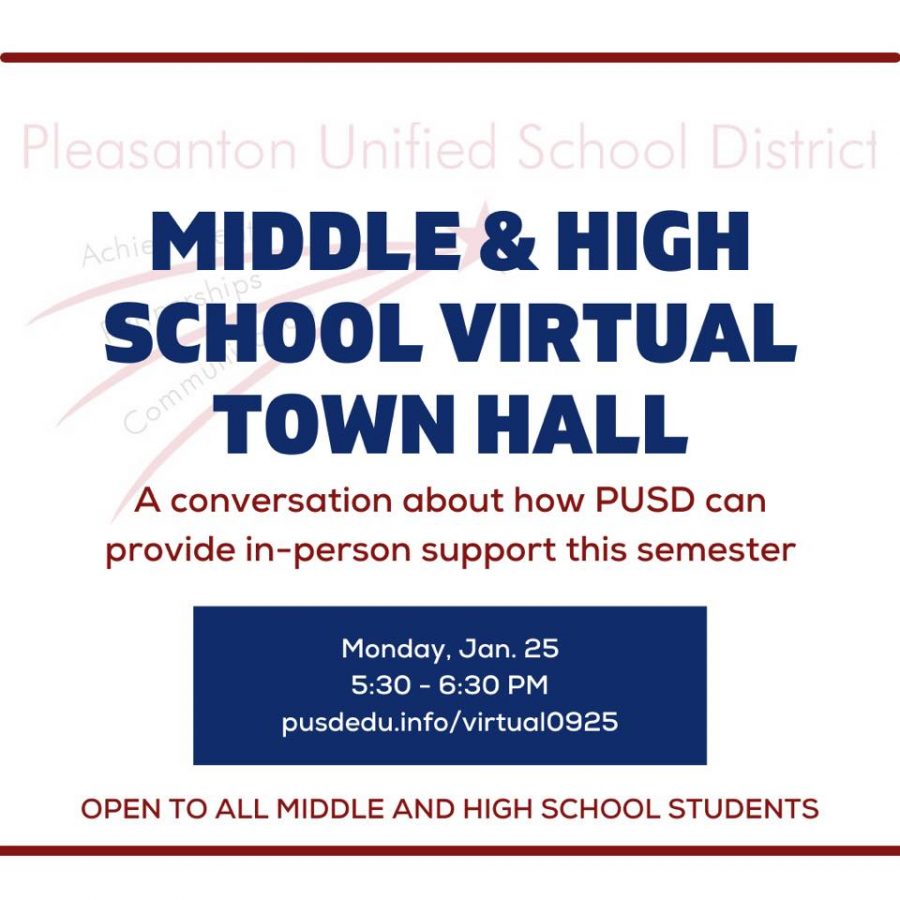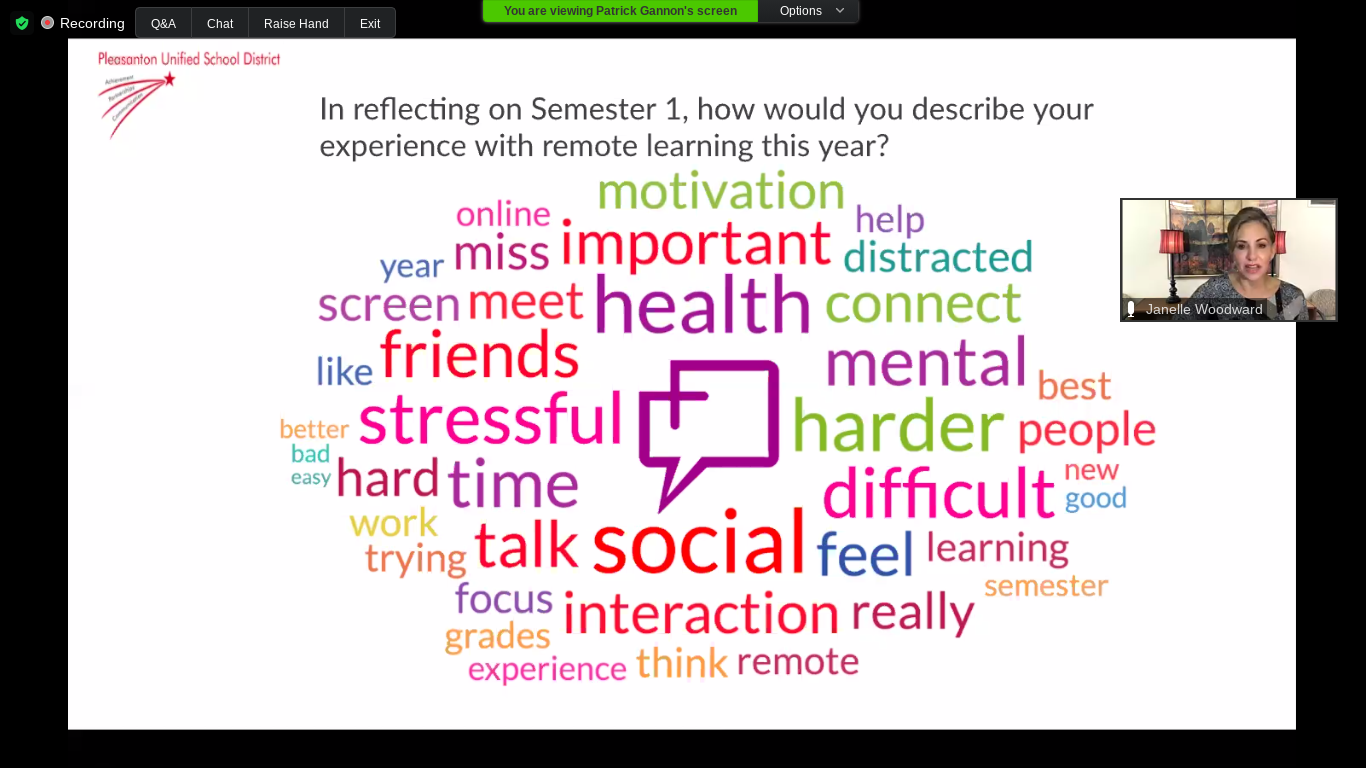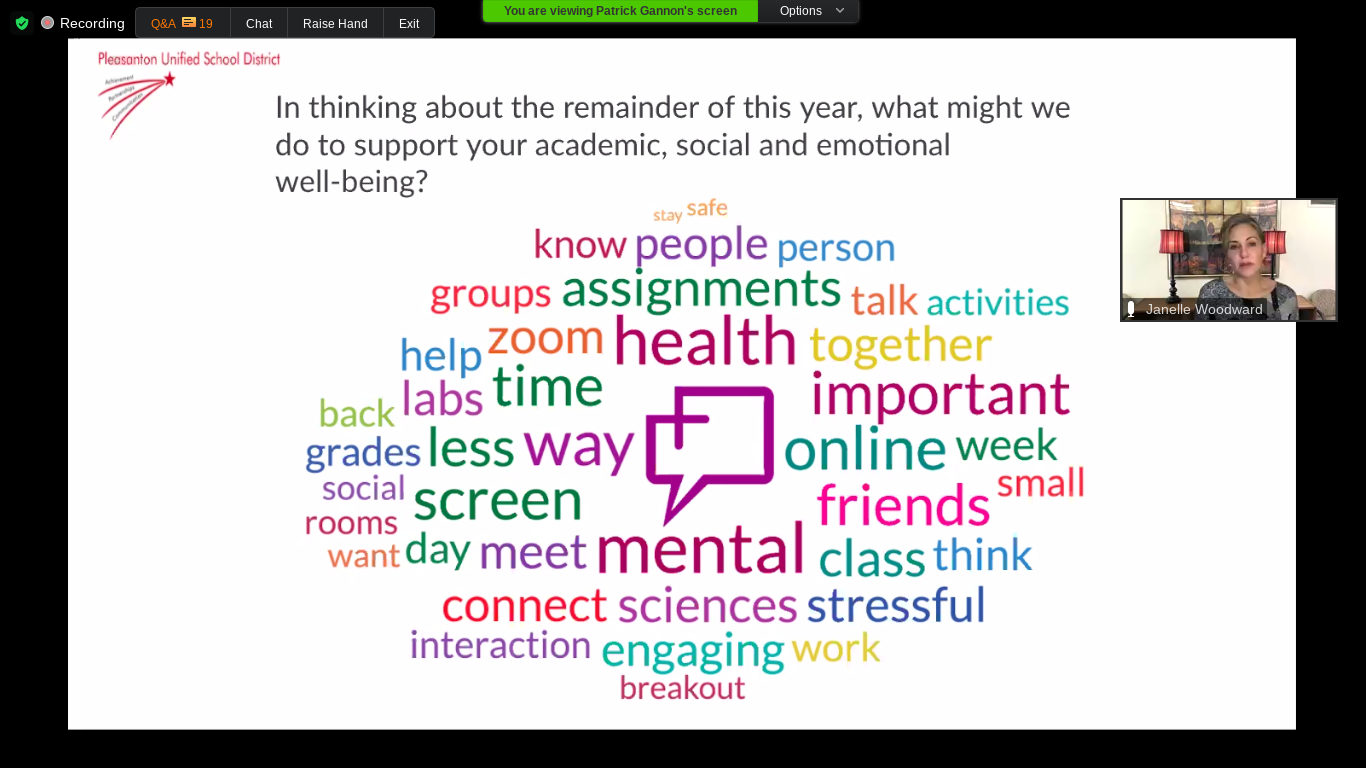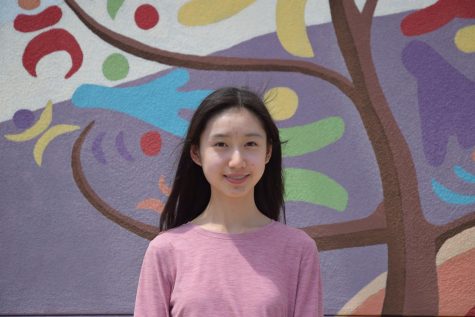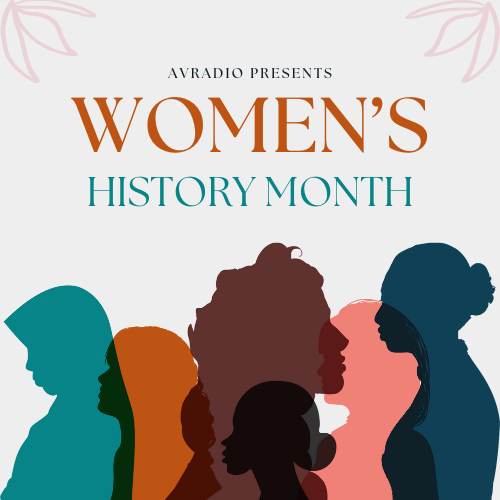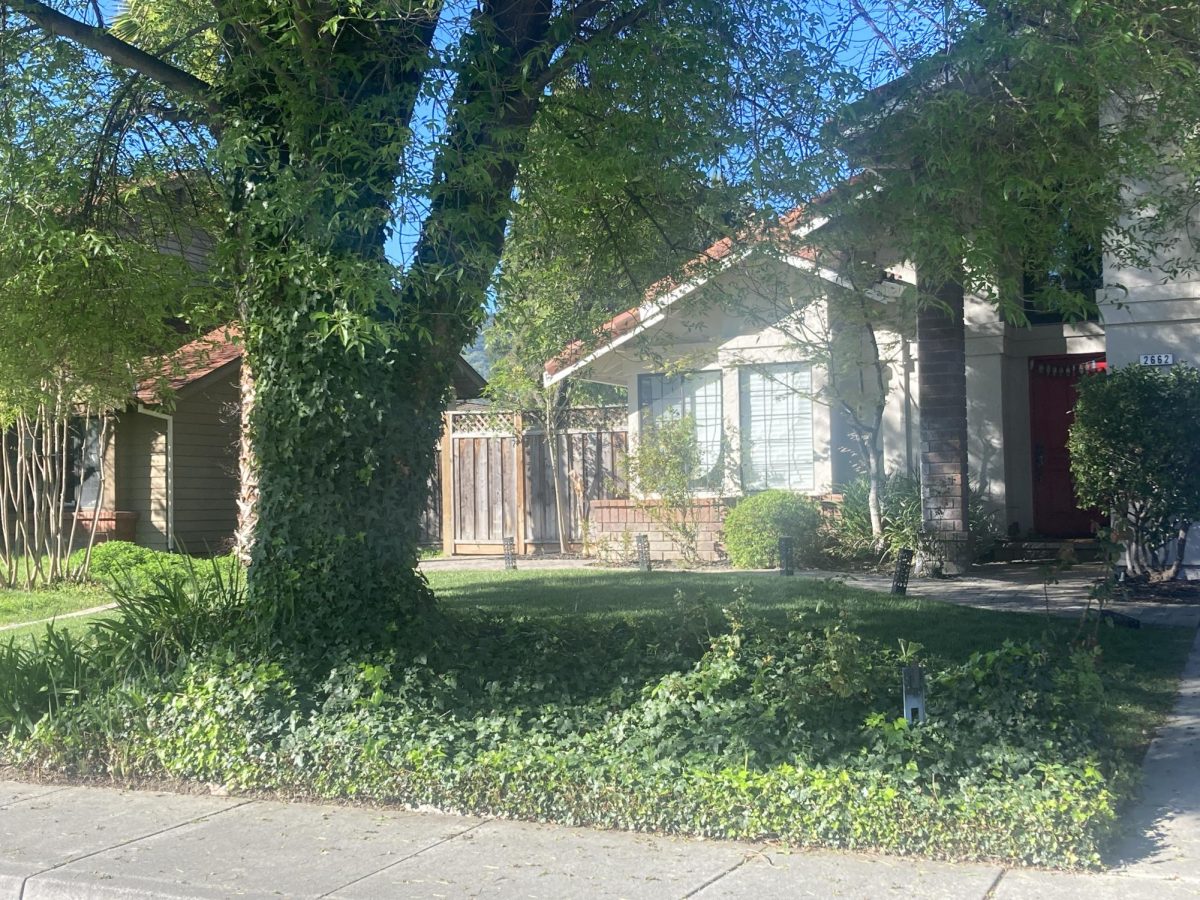PUSD Virtual Town Hall: Answers to students’ Frequently Asked Questions
Pleasanton Unified School District
On Monday’s town hall, district personnel answered many questions from middle and high school students.
January 28, 2021
On Monday, January 25, Pleasanton Unified School District held a town hall for middle and high school students. In the final thirty minutes, district personnel answered questions raised through the Q&A feature.
Speakers included Superintendent Dr. David Haglund, Assistant Superintendent Dr. Janelle Woodward, Director of Assessment and Accountability Dr. Pam VandeKamp, and Assistant Superintendent and Student Support Services Ed Diolazo, Coordinator of Communications and Community Engagement Patrick Gannon, Senior Director of Procurement and Technology Amy Nichols, and Director of Secondary Education Nimarta Grewal.
FAQ
Q: When can competitive sports resume?
Diolazo: Our EBAL, our East Bay Athletic League Coaches, have put together a plan that actually is aligned with the tier system that I explained earlier [in the hall]. So there could be some sports that could play in the purple tier, red tier, orange tier, and so forth. As I say that, that plan is actually waiting for the county to make the call as to whether competitive sports would be allowed and when that can happen so we don’t have that date yet. I do know there is a plan in place for us to follow should the county say “it’s now okay for sports to be played.”
You know, with that said, some of you may know, some of you participate, in the camps that we have established mostly at the high schools. So we have athletic camps, and there’s various camps, football, baseball, water polo, and so forth, that have happened throughout the school year, along with our band camps…we’ve had athletics and band happening since december. So, those will continue, and we want those to remain open as much as we can and even expanding them when we’re able to even when we’re in the purple tier. For sports to open we’re really waiting for the county to give us the nod, say yes.
Q: How are other districts going back by mixing cohorts?
Woodward: We keep hearing that other districts are going back and they’re mixing cohorts, and I think it’s important that everyone understands that in our county, this is not a common trend – secondary schools, meaning middle and high schools, going back. I personally know of many in California that have already gone back and had to close because of infection rates.
The other thing that’s important to note is that county guidance changes. So in some states around the country, they may have a very low rate of covid. And so their guidance might be different than our guidance. The size of the schools…matters too, in that in some secondary schools, if they have limiting offerings – and in Pleasanton we have many options for students – that might be possible for teachers to be able to go from one cohort of students to another cohort of students to another, and teachers change. But in Pleasanton, if you start at Period 1 and after Period 1 you go to Period 2, not all of the same students are in your Period 2 class, and that repeats again with Period 3, and Period 4, and so on. So it depends, to some extent, upon the size of the school, upon the structure of the school, and it also depends on the infection rate at those schools and to some extent it depends on what’s allowable in terms of, meeting in between cohorts and who’s doing that, and that the staff are able to accommodate that.
Q: Do we have to go back on campus if remote learning is going well and we are still weary about contracting Covid from going back to class?
Nichols: The answer is no, you don’t have to go back if remote learning is going well, and SB 98 has said parents can make a choice for students. If students, for fear of getting sick, are not able to go back and if remote learning is going well – we’ve heard from many of our students that it is – you will not be forced to go back.
Haglund: And just to clarify…SB 98 is the state law and so it’s not as though we could even make you come back. You always have to have that option as long as that’s in place.
Q: What’s your plan to take care of the mental, emotional, and social health of secondary students during these trying times?
Woodward: Part of our plan is learning from you, getting ideas from you this evening so that we know what we can do. It’s important for us to know – if we need to stay in remote – what else can we do to support you. So we’re looking at the Thought Exchange and at the Q&A for you to share your ideas. We might come up with ideas that we think will help, and they may not be what you need, so that’s why we’re counting on you to share that with us.
I can say that what we have done is…there is many opportunities, I read the school newsletters, for students to receive additional support, there’s counselors at the school that have been reaching out to families, so we are trying to imbed additional resources and share tools for our students for this social and emotional interaction and mental health support. We also realize that when we’re in shelter in place, we can’t do anything in person. And we’re hopeful that between now and the end of the year at the very least we can begin to create extracurricular opportunities for students to be able to come on our campuses to at least connect with each other in stable groups. And we hope that that would help with that. But I did love the idea of like the Zoom movie nights and other things like that so we may want to start thinking out of the box for ideas like that.
Diolazo: So I just want to add, Dr. Woodward , so for students who don’t know, we do have resources available on the website, the district one, and school websites. Your teachers and counselors are there for you to reach out to to talk about what you need in terms of social and emotional support. And sometimes, the reality is, it’s difficult, to reach out, but I want to say here that we are here to listen to you. This is part of the discussions tonight to listen to what your needs are, what your thoughts are, and what things we can do to support you, so just know there are resources out there both here in Pleasanton School District and also in the community that we can reach out to, so we have those resources. And if you aren’t able to access them, or you don’t know how, please reach out to an adult and just express what you need, and we’re here to help you as best as we can, but that’s where it starts, for you to tell us what you need.
Woodward: Just to add on to that, when I was a high school principal, a middle school principal or elementary principal, the thing that I would say to our students is: If you are in crisis, if you are afraid that you really need to talk to someone, then please reach out to any adult who you know that cares. Reach out, email your site administrators, email a teacher that you trust, reach out, you can reach out to any of us on cabinet – we can share our emails, we are here for you. We have resources if we know that you’re in crisis that we can connect you to someone who cares and can help you.
Q: I understand that the main plan focuses on return by grade levels. Is there any consideration of returning based on subject? There are subjects like English that work quite well online, but classes like AP Bio and Chemistry are much harder due to the fact that they are lab-based courses.
Woodward: That’s a really great question. We have thought about grade levels; we have also thought about our students who are struggling the most or who have some needs that can really be met better in the classroom, and so prioritizing certain student groups to come back first. And in terms of us deciding which classes are more important for students to come back to, that can be a little bit tricky, because some would argue that the math classes are most important. Others would argue that the classes like the arts would be most important, or the labs would be most important to come back to. And then we also have to consider the size of the classes and the sharing of equipment, so for example for the labs, we know that that would be highly problematic because students would need to share equipment and that could cause some challenges with health and safety. So it’s something that we’ll reflect on, and give some thought to.
Q: Is there a specific date when the district will simply abandon attempts to resume in-person learning in April or May?
Haglund: I don’t think there’s a specific date, our goal is to get kids back into campus as quickly as we possibly can. Having said that, there is some rationale that says “we are close to the end of the year, people need to focus, they need to make sure that they’re doing the absolute best they can in their classes,” and a continual kind of cycling or conjutating of this issue, really confuses folks and doesn’t allow them to focus. And so there is some logic to that, but I don’t know that it’s waiting until April or May. There are other districts in our area and throughout the state that have made that call and for those very reasons, so that is definitely something that we should be thinking about if the red tier doesn’t come soon enough.
Q: There’s plenty of secondary schools in the US and California that are back on campus. You said you’ve been working for the past year trying to come up with a plan. Is there a reason why we can’t adopt what these other districts have been doing and get back to school?
Woodward: I believe that we referenced that similar theme earlier when we talked about the county guidances in effect or the state guidance, the size of the school, agreements with our associations, the different offerings that our students have, and a lot of the schools that have reopened at secondary level are private schools, not public schools.
Haglund: And the uniqueness of a private school versus a public school would be?
Woodward: Generally speaking, private schools are much smaller. Generally speaking, there different bargaining agreements with the smaller schools and oftentimes they’re highly resourced so that they can continue to hire additional people to support them, and often the private schools have much smaller class sizes as well.
Haglund: What are the local school districts that you’ve had conversations with, that have been able to open? Can you just name a couple of them? So that folks know the kind of the way that you’re reaching out and taking considerations?
Woodward: The local ones that have opened? Up here? Our local school districts have not opened at the secondary level.
Haglund: Not in Alameda county?
Woodward: Not in Alameda county.
Haglund: How about other counties in the Bay Area?
Woodward: So there are some schools that have opened, and I think we heard at the last board meeting Roseville had opened, and that they had to close down again because of Covid cases. And so they’re finding a lot of the same things that we have found. There are some districts in Southern California, as well, that have planned to go back, and had to postpone those plans. I just talked to a superintendent a couple of days ago and they had planned to go back but they had to put those plans on hold too. So a lot of people say they’re going to open, but then they’re not able to actually follow up on that. That’s what a lot of districts are finding.
Q: If we go back to school next year, what will sports, theater, and classes look like? How will they work?
Woodward: Well we sure hope that we can have you all back in school this year or next year, and I would love to be able to answer that question for you right now; I don’t think any of us can because we don’t know what the health conditions will be. We don’t know where we’ll be in this virus. We continually try to predict what it’s going to look like six months from now but I can say that we’ve learned a lot. We expect that we’re on the downward trend. We have hope that we will be able to engage in more of a typical school year next year, probably with modifications. But that is our hope and that’s what we’re planning towards.
Haglund: Mr. Diolazo, do you want to add anything to that?
Diolazo: Yeah, not much more to say, I totally agree. What we think could possibly happen is that we get back to some level of normalcy, whatever that means now – I know that’s been talked about by many people, should we return. Our goal is to return this year, which you guys know. When we return next year just really depends on the status of health in the county and that’s what we’re looking towards. So if we do open, and the question was about sports, theatre, there might be some slight modifications, early on. You know, we’re really talking about six months from now, seven months from now, about the start of the school year next year, so nobody can predict for sure, but that’s our goal, is to open and try to provide an education for all of you and extracurricular sports opportunities like we did before all of this happened. But we can’t predict that, we’re going to try our best to make it happen the best we can.
Q: Those students who have been relying on sports for their PE credit, how will they be able to get their PE credits since they’ve lost their sports seasons?
Woodward: So we’re already on that, for first semester we compiled a list of all those students and our administrators are doing that right now. We took, first semester, those names to board for approval and are planning to continue with the same practice.
Q: Science has proven that the virus spreads way more easily inside than outside due to the fresh air flow. Has the district considered any outdoor options?
Woodward: Absolutely, the problem is that if everybody who should be in class is outdoors, now everybody is outdoors close together. So, there’s just, there’s some sports that would need to be outdoors, or some classes, for example any classrooms where there is singing, dancing, band instruments, or PE we know that those need to be outside. But there’s not enough outside space to accommodate technology that you need, the wifi signals, the screens, and then we have what we’re going to see for the rest of the week- times when it rains.
Q: Would you consider a block period that is 35 minutes with a 5 minute break and then 25 minutes instead of a 75 or 70 minute period? This would give time for questions too.
Woodward: We’ve received feedback from students who have expressed the same thing as the question indicated. And also from students who really like the block schedules and think that it’s learning well. So at this point in the year, frankly speaking I think it’s unlikely that we would change our current schedule but I’ve also learned that we don’t rule anything out. So if it’s the additional breaks that are needed in between classes that’s something that maybe we need to talk about.
Q: I know that this is not exactly related to the school district, but do you have any information about how AP testing is going to work?
Grewal: We’re working closely and monitoring College Board’s direction around AP testing. Currently the plan is that the exams would be in person on campus and that’s the AP direction but they also have indicated that in February they’ll be giving some additional guidance and attention for digital exams depending on health conditions. So as we learn more we’ll make sure to share with our students as we find information out.
Q: What are the district’s plans for seniors, especially graduation?
Woodward: Seniors, we know that you have not had any time on your campus this year and our administrators have already started brainstorming ideas to make graduation special. We do not want to have entirely remote graduation this year and so there are thinking out of the box and consulting with different venues or thinking of other possibilities so that it can be special for you. That’s one of our priorities.
Q: Can the school district do a better job at updating the students on such information? I think a weekly newsletter would be very helpful.
Gannon: Yes.
Haglund: Since this is a secondary town hall, maybe this is something that Director Grewal and Dr. Woodward could take back to the high school principles? And we can try to get something routinely out to you guys. And this starts with answering the questions we’re not able to get to tonight.
Q: Why can’t we have Wednesdays as instructional time? FLEX is not the same as an actual class.
Woodward: Remote instruction takes a great deal more time for teachers to plan, and so when we began the year, there were agreements that were created with the teachers union that preserved Wednesday time so that they could receive professional development – because our teachers, as you know, have had a lot to learn in terms of new strategies and new tools. It allows them to collaborate with each other and their departments to share ideas. It gives them time to look at the student achievement data, grades, so that they can get things graded and back to you, and it also allows them time to plan for upcoming lessons and post everything that they need to post on their websites. So, it is more time-intensive than having students on campus. I think all of our teachers would indicate that they’re actually spending more time this year doing lesson planning and preparing for the daily instruction than they ever have spent before. That is why Wednesdays have been set aside.
Other agenda
In the meeting, district personnel shared the current state of affairs, reviewing the colored tier system and county guidelines.
Grewal presented the results of the surveys sent out to secondary students and their parents at the beginning of the semester. The surveys revealed that for the majority, the primary reason for wanting to resume in-person learning was to fulfill the need to interact with peers, teachers, and friends.
“[The results] Indicate social connection…ranked at first choice followed by academic support and then mental health concerns, said Grewal. “Over 67% listed lack of social interaction as the biggest challenge. 40% indicated mental health concerns.”
The same sentiments were reflected in two Thought Exchanges (open until the end of the week) for students to first share their concerns, and second to suggest ideas for the coming months.
Two Word Clouds were also made (one for each Thought Exchange) using students’ most commonly used words in the exchange, and further illustrate students’ concerns with social connection.
“I think the one word that stands out to me is ‘together.’ So let’s figure this out together, as we go throughout the rest of the year. We may not all agree with how we proceed, but we will keep the lines of communication open and read through your comments so we can find ways to better support you,” said Woodward.

